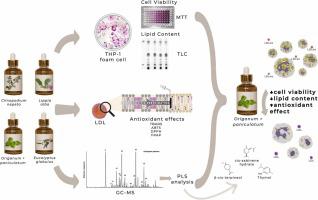Journal of Herbal Medicine ( IF 2.2 ) Pub Date : 2023-09-23 , DOI: 10.1016/j.hermed.2023.100785 María A. Castro , Juan R. Girotti , Bárbara Dumrauf , Boris Rodenak-Kladniew , María J. Zaro , Camila M. Otero , Sandra Montero-Villegas , Margarita G. de Bravo , Sonia Z. Viña , Rosana Crespo

|
Introduction
Essential oils (EOs) are mixtures of secondary plant metabolism compounds with potential lipid-lowering activity and antioxidant properties. They may therefore be considered as add-on therapy for the prevention and treatment of cardiovascular diseases.
Methods
EOs of Origanum × paniculatum (OpEO), Lippia alba (chemotype linalool) (LaLEO), Clinopodium nepeta (CnEO) and Eucalyptus globulus (EgEO), were evaluated on THP-1 foam cell macrophages as a cellular model of atherogenesis. Cell viability was determined by the MTT assay, lipid content by thin-layer chromatography, and Oil Red O staining. Antioxidant activity was evaluated by TBARS on low-density lipoprotein lipid peroxidation, and by ABTS•+, DPPH•, and FRAP assays. EOs were characterised by gas chromatography–mass spectrometry and a predictive multivariate data analysis was performed by partial least square regression (PLS) to identify the components related to antiatherogenic potential.
Results
OpEO reduced foam cell viability (IC50 = 45 µl/l) and cholesterol and triacylglycerol content and demonstrated antioxidant activity. In contrast, LaLEO increased lipid content and showed a prooxidant capacity with low reduction of cell viability (IC50 = 340 µl/l). CnEO showed prooxidant activity and reduction of cell viability (IC50 = 130 µl/l) without changes in lipid content. EgEO showed antioxidant activity, lipid increase, and low cytotoxicity (IC50 = 770 µl/l). PLS analysis suggests that cis-sabinene hydrate is responsible for cell viability inhibition, thymol and β-cis-terpineol decrease lipid content and possess antioxidant activity, and linalool increases lipid levels and has prooxidant capacity.
Conclusions
OpEO is a promising natural product for therapy against atherosclerosis, with cis-sabinene hydrate, thymol, and β-cis-terpineol as potential active principles.
中文翻译:

牛至、白唇草、荆芥和蓝桉精油的抗动脉粥样硬化潜力的体外评估
介绍
精油(EO)是次生植物代谢化合物的混合物,具有潜在的降脂活性和抗氧化特性。因此,它们可以被视为预防和治疗心血管疾病的附加疗法。
方法
在作为动脉 粥样硬化形成细胞模型的 THP-1 泡沫细胞巨噬细胞上评估牛至花 (OpEO)、白唇花(化学 型芳樟醇) (LaLEO) 、荆芥(CnEO)和蓝桉(EgEO)的 EO 。通过MTT测定法测定细胞活力,通过薄层色谱法测定脂质含量,并通过油红O染色测定。通过TBARS对低密度脂蛋白脂质过氧化作用以及ABTS •+、DPPH •和FRAP 测定来评估抗氧化活性。通过气相色谱-质谱法对 EO 进行表征,并通过偏最小二乘回归 (PLS) 进行预测性多变量数据分析,以确定与抗动脉粥样硬化潜力相关的成分。
结果
OpEO 降低泡沫细胞活力 (IC50 = 45 µl/l) 以及胆固醇和三酰甘油含量,并表现出抗氧化活性。相比之下,LaLEO 增加了脂质含量,并显示出促氧化能力,同时细胞活力降低程度较低(IC50 = 340 µl/l)。CnEO 显示出促氧化活性并降低细胞活力 (IC50 = 130 µl/l),且脂质含量没有变化。EgEO 显示出抗氧化活性、脂质增加和低细胞毒性 (IC50 = 770 µl/l)。PLS分析表明,顺式桧烯水合物负责细胞活力抑制,百里香酚和β-顺式萜品醇降低脂质含量并具有抗氧化活性,芳樟醇增加脂质水平并具有促氧化能力。
结论
OpEO 是一种很有前景的治疗动脉粥样硬化的天然产物,其中顺式桧烯水合物、百里酚和 β-顺式萜品醇是潜在的活性成分。


















































 京公网安备 11010802027423号
京公网安备 11010802027423号